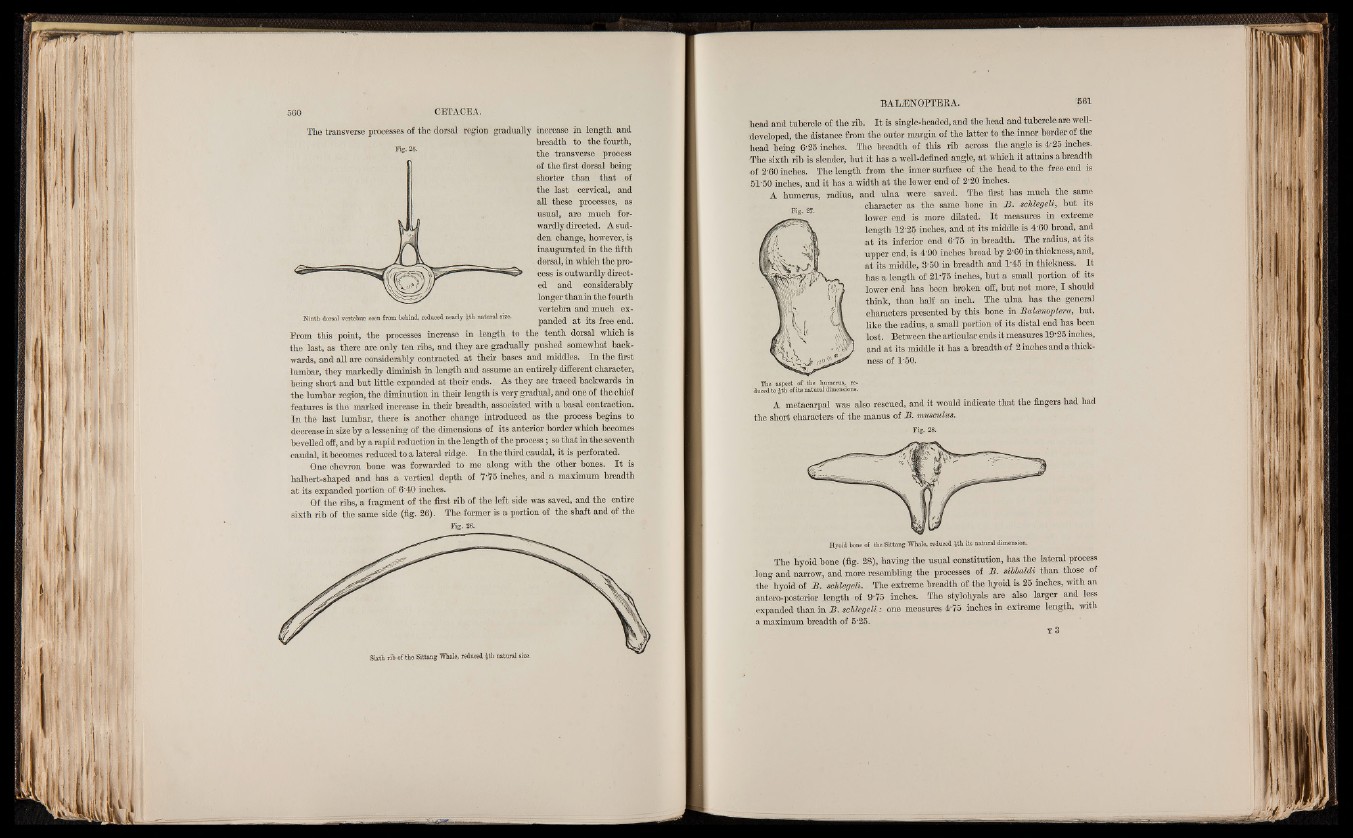
The transverse processes of the dorsal region gradually increase in length and
hreadth to the fourth,
the transverse process
of the first dorsal being
shorter than that of
the last cervical, and
all these processes, as
usual, are much forwardly
directed. A sudden
change, however, i§
inaugurated in the fifth
dorsal, in which the process
is outwardly directed
and considerably
longer thanin the fourth
vertebra and much ex-
Ninth dorsal vertebrae seen from behind, reduced' nearly $th natural size. panded at its free end
Erom frhis point, the processes increase in length to the tenth dorsal which is
the last, as there are only ten ribs, and they are gradually pushed somewhat backwards,
«Tid all are considerably contracted at their bases and middles. In the first
lumbar, they markedly diminish in length and assume an entirely different character,
being short and but little expanded at their ends. As they are traced backwards in
the lumbar region, the diminution in their length is very gradual, and one of the chief
features is the marked increase in their breadth, associated with a basal contraction.
In the last lumbar, there is another change introduced as the process begins to
decrease in size by a lessening of the dimensions of its anterior border which becomes
bevelled off, and by a rapid reduction in the length of the process; so that in the seventh
caudal, it becomes reduced to a lateral ridge. In the third caudal, it is perforated.
One chevron bone was forwarded to me along with the other bones. I t is
halbert-shaped and has a vertical depth of 7*75 inches, and a maximum breadth
at its expanded portion of 6*40 inches.
Of the ribs, a fragment of the first rib of the left side was saved, and the entire
sixth rib of the g«™* side (fig. 26). The former is a portion of the shaft and of the
head and tubercle of the rib. I t is single-headed, and the head and tubercle arte well-
developed, the distance from the outer margin of the latter to the inner border of the
head being 6-25 inches. The breadth of this rib across the angle is 4-25 inches.
The sixth rib is slender, but it has a well-defined angle, at which it attains a breadth
of 2*60 inches. The length from the inner surface of the head to the free end is
51-50 inches, and it has a width at the lower end of 2'20 inches.
A humerus, radius, and ulna were saved. The first has much the same
character as the same bone in B. schlegeli, but its
lower end is more dilated. I t measures in extreme
length 12-25 inches, and at its middle is 4*60 broad, and
at its inferior end 6*75 in breadth. The radius, at its
upper end, is 4*90 inches broad by 2*60 in thickness, and,
at its middle, 3-50 in breadth and 1-45 in thickness. It
has a length of 21*75 inches, but a small portion of its
lower end has been broken off, but not more, I should
think, than half an inch. The ulna has the general
characters presented by this bone in Balcenoptera, but-,
like the radius, a small portion of its distal end has been
lost. Between the articular ends it measures 19*25 inches,
and at its middle it has a breadth of 2 inches and a thickness
of 1*50.
The aspect of the humerus, re- \
duced to £th of its natural dimensions.
A metacarpal was also rescued, and it would indicate that the fingers had had
the short characters of the manus of B. musculus.
■ Fig. 28.
Hyoid bone of the Sittang Whale, reduced fcth its natural dimension.
The hyoid bone (fig. 28), having the usual constitution, has the lateral process
long and narrow, and more resembling the processes of B. sibbaldi than those of
the hyoid of B . schlegeli. The extreme breadth of the hyoid is 25 inches, with an
antero-posterior length of 9*75 inches. The stylohyals are also larger and less
expanded than in B. schlegeli : one measures 4*75 inches in extreme length, with
a maximum breadth of 5*25.
t 3